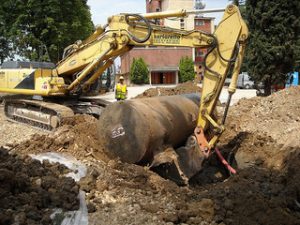 Closure – taking an underground storage tank out of service permanently – is the final step in the tank’s life cycle. The process is governed by federal and state regulations because proper underground storage tank removal is just as important to protecting surrounding soil and groundwater as is ongoing monitoring while the tank is in use.
Closure – taking an underground storage tank out of service permanently – is the final step in the tank’s life cycle. The process is governed by federal and state regulations because proper underground storage tank removal is just as important to protecting surrounding soil and groundwater as is ongoing monitoring while the tank is in use.
Even a small amount of contamination that leaches into groundwater can have far-reaching and devastating effects on drinking water for humans and animals, and it can potentially destroy plant life and fish habitats. Any toxic waste that remains after underground storage tank removal must be cleaned up to protect public and environmental health.
If it’s time for you to decommission a tank, there are two ways to approach the situation so your underground storage tank removal project goes smoothly.
1. Learn everything you can about what’s involved.
The removal process follows these basic steps:
- Obtaining permits and contacting Dig Safely NY (or similar entity if you’re in another state) to locate utilities that could be adjacent to your removal site.
- Uncovering the tank and eliminating any vapors that are present.
- Removing any remaining product and residue from the tank.
- Physically inspecting the tank’s interior for leaks or damage.
- Visually inspecting the surrounding area and taking soil samples to test for presence of hazardous substances.
If all is clear, your tank and associated piping may be removed and properly disposed of, then the hole can be refilled and regraded. In some cases, underground storage tank removal won’t even be necessary. Instead the tank can be filled with sand or concrete slurry and left in place permanently. Check to see if your local municipality allows this procedure.
If hazardous substances are detected or additional testing is indicated, you’ll have to prepare a remediation plan.
2. Hire someone who knows what they’re doing.
As with many other things, the cheapest alternative may not be the smartest, especially if you discover contamination. Removal, sampling and reporting can be performed by different companies, but you do not want to run the risk of sloppy or unscrupulous actions that could put your project at risk or cost you too much.
Underground storage tank removal is a science-based process. So it makes sense to hire a reputable environmental engineering firm that holds all the appropriate certifications and licenses and has the knowledge and experience to guide you well. A pro knows the rules. They can perform or expertly oversee each phase of your underground storage tank removal process to ensure all goes smoothly, including:
- Coordinating with all official agencies.
- Preparing specifications, reviewing bids and supervising contractors.
- Ensuring soil excavation is thorough but nothing that isn’t contaminated is removed, which could cost you unnecessarily.
- Soil sampling and analysis.
- Ensuring you receive proper documentation of the removal process and findings, important to meet regulatory requirements but also for your own permanent records.
- Representing you with regulators if remediation or other questions arise.
And if it turns out remediation is needed, they can help you develop the most effective – and cost-effective – plan and get the work completed as quickly as possible so you can move on.
A professional engineering consultant can also conduct regular periodic compliance inspections and create a budget-conscious monitoring program to ensure ongoing storage tank safety and compliance. That way you’ll be confident of compliance and well-prepared for whatever comes along.
There’s much more to underground storage tank removal than simply digging a hole. Knowing the physical work was handled properly, the scientific work was performed thoroughly and accurately and your property is free of hazardous substances – or you have a solid plan in place to clean it up – will give you peace of mind. And nothing is smoother than that.
Photo Credit: US Army Environmental Command
